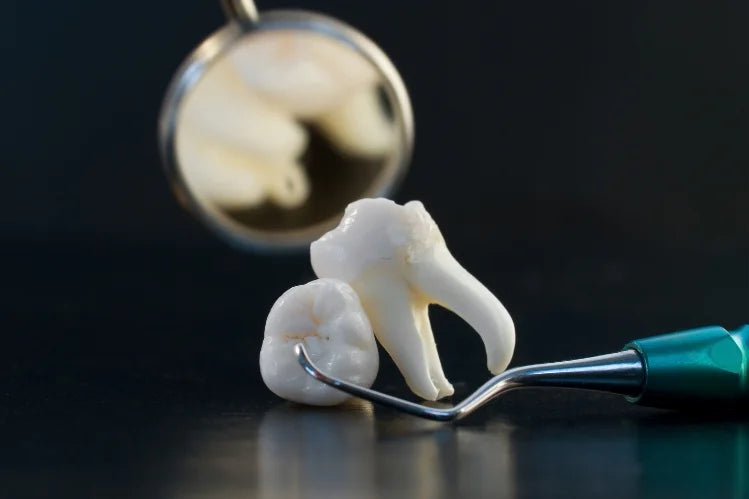
Table of Contents
-
What are Wisdom Teeth?
-
5 Common Wisdom Teeth Scenarios
-
When Should Wisdom Teeth Be Extracted?
-
Wisdom Teeth Extraction Before Teeth Straightening
-
Can Braces Straighten Wisdom Teeth?
-
Can Clear Aligners Straighten Wisdom Teeth?
-
Do Wisdom Teeth Make It Harder to Straighten Your Teeth?
-
Using Clear Aligners After Wisdom Teeth Removal
-
What Happens If Your Wisdom Teeth Emerge During Treatment?
-
Get Started with Smilepath
-
FAQs
If you are considering getting braces or clear aligners, you might be asking what you should do about your wisdom teeth before you begin wearing them. Additionally, you might want to know if they would be a problem if they showed up during or after your treatment.
In this article, we have addressed all of the frequently asked issues regarding orthodontic treatment and wisdom teeth, debunking some popular misconceptions.
What are Wisdom Teeth?
Wisdom teeth, often called third molars, are next to the throat and typically flatter than other teeth. When wisdom teeth emerge, the position of the other teeth in the row may be affected, and they may also cause excruciating pain. However, misaligned wisdom teeth don't always cause problems; some people can have misaligned molars without any consequences to the other teeth.
Having misaligned wisdom teeth is probably not something that will go away on its own. Most often, wisdom teeth that are painful or sensitive are extracted along with crooked wisdom teeth that affect the rest of the teeth' alignment and functionality.
If the wisdom teeth don't bother the other teeth, they can be kept without any problems.

5 Common Wisdom Teeth Scenarios
Dentists believe that over time, our jaws have evolved to become smaller due to changes in our diets and improved dental care. As a result, many people experience different outcomes with their wisdom teeth, such as:
- Wisdom teeth grow in perfectly.
- A gum flap partially covers the wisdom teeth.
- Wisdom teeth come in at an angle due to a lack of space in the mouth.
- Wisdom teeth remain hidden below the gums.
- Some people don't develop wisdom teeth at all.
When Should Wisdom Teeth Be Extracted?
Some people think that getting your wisdom teeth extracted is a good way to avoid future problems. To protect future oral health, wisdom teeth are sometimes extracted before they completely emerge, even if they aren't causing any problems at the moment.
In some cases, the location or alignment of the teeth prevents the wisdom teeth from emerging normally, and while removing them might not stop lower teeth from crowding, this is not always the case. The progress of your wisdom teeth can be monitored by your dentist during routine visits. Dentists may recommend oral surgeons for extraction in cases when the following conditions apply:
- The surrounding soft tissue swells or becomes infected
- The teeth are partially or completely impacted
- The teeth's positioning makes them difficult to clean.
Another reason for removal could be:
- Risk of gum disease and cavities
- If the impacted teeth cause headaches and sinus pain
- In rare cases, benign tumors or cysts are formed in the jaw.
However, if the wisdom teeth are not causing pain or impacting oral health, an orthodontist will not automatically advocate removing them before beginning treatments such as aligners or braces, only as a precaution.

Wisdom Teeth Extraction Before Teeth Straightening
If your orthodontist has recommended getting your wisdom teeth extracted before starting orthodontic treatment, it's helpful to know what to expect so you can avoid unnecessary anxiety.
Wisdom tooth extraction is a common operation that many dentists conduct in their clinics. But if a patient's wisdom teeth are severely impacted, the dentist may recommend an oral surgeon.
Sedation or Local Anesthesia
In some cases, your dentist may use sedation or a local anesthetic to make the process easier. If your dentist administers sedation, you will sleep throughout the wisdom teeth extraction operation.
The Process in the Case of Local Anesthesia
To numb your gums before operating around each wisdom tooth that needs to be extracted, the dentist will first apply a numbing gel to your gums. Although you will remain awake, you won't experience any pain, just a feeling of pressure and movement in your gums.
A small incision will be made into your gum line by your dentist to expose the wisdom tooth and bone during the extraction process. He or she will next extract the wisdom teeth, either completely or partially. After that, your dentist will clean the area and seal the wound. To stop the bleeding, you might need to cover your cut with gauze.
Can Braces Straighten Wisdom Teeth?

Getting braces is a great way to improve the alignment of your teeth and your smile, but they won't fix your wisdom teeth. Wisdom teeth are situated in the very back of the mouth and frequently do not have enough room to emerge properly, which can lead to crowding, impaction, or alignment problems.
Wisdom teeth that are impacted or ill-positioned are typically extracted as opposed to straightened. While wisdom teeth can erupt without impact in some individuals with healthy jawbones and adequate space, braces are typically not recommended for wisdom teeth correction.
Can Clear Aligners Straighten Wisdom Teeth?

One of the most recent and significant developments in orthodontic technology is clear aligners. This method of straightening teeth involves wearing a set of discrete plastic trays that are custom-made for you. You've undoubtedly wondered if clear aligners can correct wisdom teeth.
If wisdom teeth are present, they can be somewhat improved with clear aligners. Although extraction may be necessary for severely misplaced wisdom teeth. Even if your wisdom teeth aren't fully aligned, clear aligners can provide the impression that your teeth are straighter by straightening the teeth that surround them and improving the wisdom teeth themselves.
If you are considering clear aligners but still have your wisdom teeth, consult your orthodontist to determine whether or not this treatment option is best for you.
Do Wisdom Teeth Make It Harder to Straighten Your Teeth?
Wisdom teeth usually don’t interfere with straightening your teeth. Whether or not you have wisdom teeth, you can still use clear aligners, like those from Smilepath, to straighten your visible teeth. Even if your wisdom teeth are still coming in, aligners focus on moving the teeth you can see—wisdom teeth aren’t included in that process.
Some people worry that their wisdom teeth might push other teeth out of place as they grow, but that’s not really the case. When wisdom teeth emerge, they only apply a small amount of pressure, which isn’t enough to make your other teeth crooked. If your teeth do shift, it’s more likely because you’re not wearing your aligners properly or other factors are at play.
Using Clear Aligners After Wisdom Teeth Removal
If you do need to have your wisdom teeth removed, you’ll need to wait before starting the clear aligner treatment. Your mouth will need time to heal, which typically takes around six weeks. However, in some cases, you might be able to start your aligner treatment sooner. It’s best to talk to your dentist and follow their advice to ensure proper healing and maintain good oral health.
What Happens If Your Wisdom Teeth Emerge During Treatment?
If you haven’t had your wisdom teeth removed and they haven’t come through yet, there’s a small chance they could start to come in while you’re wearing aligners. If your dentist hasn’t recommended removing them, there’s no need to worry about them coming in during your treatment.
If your wisdom teeth do start to come in, you can usually continue treatment. However, you might need to pause if the new teeth are causing issues. If your wisdom teeth start causing pain or other problems, your dentist may recommend removal. In that case, you’ll need to wait about six weeks after extraction before resuming Smilepath treatment to give your mouth time to heal.
Get Started with Smilepath
When you request an impression kit from Smilepath, we’ll evaluate your teeth and create a smile projection for you to approve. To find out if you’re a candidate, you can start with our quick and free online assessment. It only takes a few seconds to answer key questions and see if our treatment is right for you.
Your wisdom teeth likely won’t impact your ability to get treatment from Smilepath. In most cases, they won’t make any difference. If you’ve already spoken with your dentist, the next step is to complete our free assessment. Feel free to call us with any questions or if you’d like more information!
FAQs
No, wisdom teeth typically don’t affect your ability to use clear aligners. Aligners focus on straightening your visible teeth, and wisdom teeth are often not included in that process.
Not necessarily. If your wisdom teeth aren’t causing any problems, you can start treatment without having them removed. However, if they cause pain or discomfort, your dentist may recommend removal before treatment.
If your wisdom teeth begin to come in during treatment, you can usually continue wearing your aligners. In some cases, you might need a brief pause if the new teeth cause issues, but you can resume treatment once the situation is managed.
After wisdom teeth removal, you typically need to wait about six weeks for your mouth to heal before starting aligner treatment. Your dentist will guide you on the best time to begin.




 Australia
Australia New Zealand
New Zealand Malaysia
Malaysia English
English Portuguese
Portuguese English
English English
English English
English English
English English
English Canada
Canada